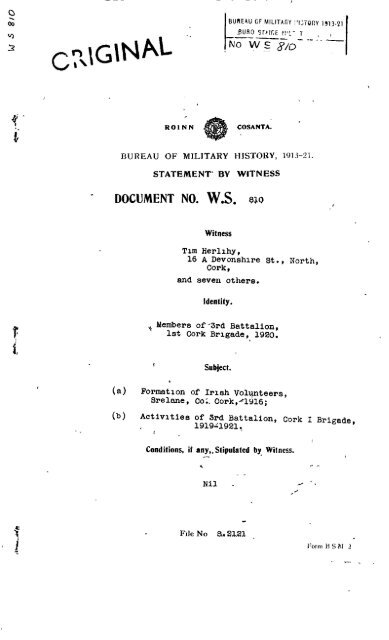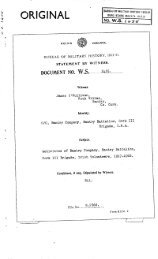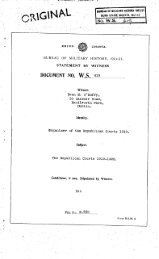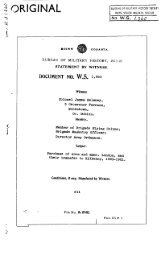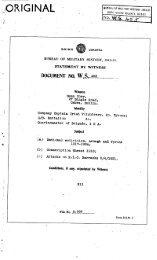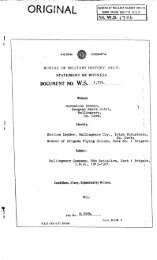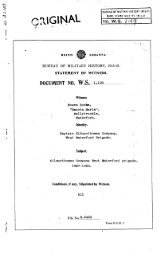ROINN COSANTA. BUREAU OF MILITARY HISTORY, 1913-21 ...
ROINN COSANTA. BUREAU OF MILITARY HISTORY, 1913-21 ...
ROINN COSANTA. BUREAU OF MILITARY HISTORY, 1913-21 ...
You also want an ePaper? Increase the reach of your titles
YUMPU automatically turns print PDFs into web optimized ePapers that Google loves.
-2-Leo Murphy of Fianna Erieann. The training consistedmostly of drill at first for the purpose of discipline andas the Company gradually increased in strength by twos andthrees from the original six it was able to be organised ona proper basis.Then Peter O'Donovan was sent by Brigade Headquartersto instruct in tactics, and Florrie O'Donoghue used to carryout inspections and give talks on the objects for which thpVolunteers were formed. Leo Murphy continued as instructorto the Company.The first public parade of the Srelane Company washeld one Sunday in January, 1917, greatly to the astonishmentof all the people outside Knockanemore Chapel, the parishchurch for Ovens and Srelane. Subscriptions by members ofthe Company had been spent in purchasing slouch hats for alland the Officers had Sam Brown belts. All carried hurleys.The Company went on a route march after Mass from Ovensround by Kilcrea Abbey and Brelane. There was another routemarch on the following Sunday and drilling was carried outat Farnivane in the presence of two B.I.C. men who followedthe Company on its march but did not otherwise interfere.Up to March, 1917, Srelane Company had increasedtremendously in numbers and was eventually divided intotwo Sections, Srelane and Killumney. Killumney thenbecame an independent Company. Now the Volunteers, a goodnumber of them, had arms and ammunition, though the armsconsisted principally of shotguns. Being a farmingdistrict, every farmhouse had a shotgun and even though
-3-these may have belonged to the head of the house, it was theVolunteer son or sons got possession of the family shotgunand eventually they were all collected together and put intothe Company dump.During the threat of conscription in April, 1918,lQO5 of the men in the area joined the Volunteers and allprepared to resist conscription determinedly.Now the British authorities prohibited meetings andgames. However, a camogie match and aeridheact (which wereorganised to get money for the arms fund) were advertised tobe held at Garryheston one Sunday in May, 1918. Thefunction was prohibited by the British and so the word waspassed around and everyone went to Coakley's field atBegley's Forge and the camogie match was started. TimHerlihy was the referee. Soon some R.I.C. men were on thescene and regarding him as the man responsible, as indeedhe was, for he was O.C. Srelane Company, they tried tointercept him as he ran up and down the field, apparentlyintent on the game but really evading them. They dashedhere and there after him but the players got in their wayand they were being made a laugh of by the onlookers. Thenthe military came and with fixed bayonets dispersed thecrowd. The Volunteer Band from Cork was in attendanceand two of its members, Wickham and McCorry, were arrestedand got a month in jail for unlawful assembly.It is interesting to mention that in this same year,1918, the Volunteers of the two Companies planted a treefor each one of the 1916 leaders who had been executed.
-4-The trees were planted near the main Cork-Macroom roadbetween Srelane and Farran on Gerald Desmond's land, thefirst farmhouse along the road after Srelane. A groveof trees gew up here during the later years.The chief activities of a military nature during 1918were parades for drill and tactics, but when 1919 cameraiding for arms started. The R.I.C. had orders from theBritish Government to collect all privately owned arms butin our area they were forestalled, the Volunteers doing thecollecting before them. Houses of loyalists which wereraided were Clarke's of Farran, Hornibrook's of Killumney,McGivern's of Waterfall and also Castle White at the sameplace. A good supply of arms was collected. When theVolunteers came to Hornibrook's house, however, he spoke outof a window to them and said he would resist. In thecourse of his declarations, he quoted Mr. Gladstone as havingonce said that every man's house was his castle and so hewas going to defend his. And so he did and defended itwell. He was a good shot but after half an hour's fightthe Volunteers forced their way in and compelled hissurrender. No one was hurt on either side but threerevolvers with about 300 rounds of ammunition for them andtwo shotguns were secured.From 1916 to 1919 in the area which was to be knownlater as the 3rd Battalion, 1st Cork Brigade, things weregenerally quiet, but now arid again the military and R.I.C.enforced their rule, which acted as a stimulus on thecivilian population. There was a spirit growing in theaarea and organisers came along from outside, principally
-5-from Cork City, so things went on until 1919 when the 3rdBattalion was formed with Leo Murphy as Commandant.The Battalion was made up of Companies from 'A' to'F' and, while operating as such, consisted of from 300to 350 Volunteers. At its formation, the Battalion wasbadly equipped with arms, etc., but raids carried out byeach Company in their own area did much to help, but thecaptures were, on the whole, only shotguns and an oddrevolver.In the meantime, the Battalion was going through acourse of training, the usual drill that went to themaking of a Volunteer and fitting each man for sternerworklater.It might be no harm to mention that in the area therewas one Military Barracks (Ballincollig village) garrisonedby the Manchester Regiment, commanded by an Officer namedDowling ('C' Company Area), one R.I.C. Barracks one mileto the West ('B' Company Area), which was Headquarters,with a complement of about 30 men, and a sprinkling ofBlack and Tans, under a D.I. To the West of this, about8 miles, was another R.I.C. Barracks in Farran ('E' CompanyArea), held by 8 or 9 men, to the East of BallincolligBarracks, about 5 miles from Cork City. All those ledin a direct route from Cork to Macroom on the old coachroad. Scattered through the area were the loyalists andsupporters who had to be dealt with, sometimes burned outor deported. Those actions often led to raids by themilitary and R.I.C., especially in and around Waterfalland Ballinora ('C' Company).
-6-The usual Battalion Council meetings were heldregularly, but the venue was changed to meet occasions.In May, 1919, the 3rd Battalion Was organised.Florrie O'Donoghue, Cork I Brigade Adjutant, supervisedan election of Officers at Srelane in that month. TimHerlihy Was elected Battalion Commanding Officer. The3rd Battalion now comprised three Companies-Srelane,Killumney and Ballinora. Tim Herlihy then organisedAherla, Farran and Farnanes and this number of Companiesmade up the 3rd Battalion during the remainder of the periodup to the Truce In July, 19<strong>21</strong>.From the 1st April, 1919, to the 31st March, 1920,Tim Herlihy perfected the Battalion organisation. Thefollowing was the Battalion Staff and Officers and N.C.Os.of the six Companies at this time, the first-mentionednames in the list represent the holders of the appointmentsduring the period above-mentioned, the others beingsuccessors at later dates :Battalion Headquarters' Staff: (with succeeding Officers).O.C. Tim Herliby. Leo Murphy. Michael O'Regan.V/O.C. Jerry O'Shea. James Foley. M.ORegan. M. Foley.Adjutant, Willie Cotter. Daniel Keane.Q.M. Tom Hickey. N. O'Regan. T. O'Keeffe. B. Colley.Signals. John Sullivan. Jeremiah Hurley.Engineers. Michael O'Connell.I.0. Tim O'Keeffe. James Ahern.Liaison andCommunicationsOfficer betweenI and IIIBrigades. Dick Cotter.
-7-'A' Coninanv. Srelane.Strength: 720.C. Tim Healy. J. O'Brien.1st Lieut. D. Flavin.2nd Lieut. J. O'Brien. T. Hallissey.Adjutant. Jack Herlihy.Q.M. Jerh. Herlihy.Signals. Jerh. Hallissey.Engineers. Paddy Galvin.I.C. Denis O'Sullivan.Section Leaders: Tim Hallissey.MattyO'Leary.'B' Company. Killumney.Strength: 680.C. Sonny O'connell. Thomas Keobane.1st Lieut. Jack Delaney. Larry Scannell. Tom Donovan.2nd Lieut. Larry Scannell. -Coakley.Connie0 'Sullivan.Adjutant. Patrick Coakley.Q.M. Tim Coakley.Signals. Danny Scannell.Engineers. Patrick Collins.I.0. John O'Connell. Georgie O'Brien.Section Leaders: Tim O'Brien. Jack Cotter.Jimmie Callaghan. Jack Sullivan.
-8-'C' ComDanv. Ballinora.Strength:O.C.J. Murray.1stLieut.P. Donovan.D. Mahony.2ndLieut.DickLucy.P. Donovan.Adjutant.Q.M.F. O'Sullivan.H. Murphy.J. Lynch.T. Riordan.Signals.DanielForde.Engineers.C. O'Shea.1.0.J. Murphy.J. Ahern.SectionLeaders:J. Horgan.D. Forde.D. Donovan.J. Ryan.'D'Company.Strength:Aherla.46O.C.JamesFoley.PatrickCronin.1stLieut.PatrickCronin.2ndLieut.T. Foley.Adjutant.P. Walsh.Q.M.JohnBurns.Signals.Engineers.J. Lynch.T. Mahony.I.0.Denis0 'Callaghan.SectionLeaders:John Lynch. Jack Dineen.J. Ahern. Jim Cough].an.
-9-'E' Company. Farran.Strength: 50O.C. Seán Hayes (later 0.C. Bn. Column.)Dan Desmond.1st Lieut. Dan Desmond.2nd Lieut. Patrick Murphy.Adjutant. Patrick O'Leary.Q.M. Denis Desmond.Signals. Michael Murphy. John Flynn.Engineers. Richard O'Regan. John Murphy.I.0. Michael Ahern.Section Leaders: John Murphy. Patrick O'Leary.Patrick Rice. Michael O'Callaghan.'F' Company. Farnanes.Strength: 700.C. Jeremiah Carroll.1st Lieut. John Lane.2nd Lieut. Michael O'Connor.Adjutant. Denis Hennessy.Q.M. Cornelius Lynch.Signals. Daniel O'Connor.Engineers. John O'Connor.I.O. Daniel O'Mahony.Section Leaders: Daniel Lyons. Jeremiah Healy.Laurence O1Leary. Richard Walshe.
-10-The 3rd Battalion found an ideal Headquarters atCullinanes (Old House) near Aherla. It was at this housethat prisoners from both the 1st and 3rd Brigades weredetained. Transgressors against the common law asadministered by the Irish or Sinn Féin Courts and also spiesand informers were brought here. Here also many spieswere courtmartialled and shot later in the war.In November, 1919, when Torn Hales was 0.C. Cork IIIBrigade he sent some prisoners to 3rd Battalion Headquartersfor trial. These were the first offenders tried by anIrish Republican Court, probably, in Cork County. SeanBuckley of Bandon was Chairman of the Court between April,1920, end ofAnd March, 19<strong>21</strong>. Other Court members weretheWillie Walsh of Bandon, Michael Coholan, nephew of theBishop of Cork, and John Scannell. All cases wereequitably dealt with and the Court administered justiceimpartially, as the members well understood local conditions.The British Courts ceased to function as all local cases werebrought.beforethe Sinn Féin Court. Protection during theCourt sittings and police duties were provided by 'D' Company,in whose area the Courthouse was situated. This Companyalso guarded prisoners, whether criminal or political.Thompson and the Herons, senior and junior, must havebeen the first prisoners to have been expelled from Irelandby a Republican Court. They were strongly suspected ofbeing spies for the British but there was not sufficientevidence to convict them, so, instead, they were expelledfrom the country. They had been passed on from the III
-14-Farm Road. Thompson had previously raided Leo Murphy'smother's house. He was drunk at the time and boastedthat he was out to get all I.R.A. leaders as he had gotthe leaders in Egypt. He treated Rose Murphy very roughlyand this helped to cause her early death. When capturedhe tried to save himself by informing his captors that acease fire was coming and that Ireland was getting DominionHome Rule. He said he had this from Dublin Castle.This special pleading didn't work, however, and he was shotout of hand.Captain Thompson was suceeded as I.0. by CaptainVining. It was he who shot Leo Murphy on 27th June, justa fortnight before the Truce. Leo Murphy was then 0.C.3rd Battalion, having succeeded Tim Herlihy, who was takenprisoner by the British. Apparently Vining was acting oninformation supplied him about Leo Murphy's movements forhe and about five other British Officers drove up in a carto Donovan's public house at Waterfall one evening andsurrounded the house. There were about forty-four in allin the pub, the great majority of whom were elderly menwho had been attending a bowling match in the locality.Of all the crowd there were only a fey Volunteers. Twoof them escaped, but Leo Murphy, who tried to shoot hisway out, was shot dead. Another Volunteer, Charlie Daly,who was unarmed, was taken away by Captain Vining and hisparty and his dead body was found at Douglas the nextmorning. He had been shot. Daly belonged to the 2ndBattalion (Cork City).
-15-On 4th October, 1920, the Battalion endeavoured tocarry out an ambush of British military travelling by lorryalong the Bandon road Just South of the Chetwynd Viaduct onthe Cork, Bandon and South Coast Railway. The Volunteerswere in position but were surrounded by military from Cork,it was assumed from information given, and with difficultygot away with all their arms and ammunition, all but one man,Jeremiah O'Herlihy, who was wounded after being takenprisoner and died later in hospital in Cork. Over sixfeet, with a magnificent physique, a sincere Volunteer,Jeremiah O'Herlihy, 0.C. Signals, 3rd Battalion, died forIreland October l1fth, 1920.Jeremiah O'Herlihy held a position commanding a cleartwo mile view of the road each way from our ambush position.His duty was to signal the enemy approach. We believe hissense of duty made him hold his position too long.Captured by the enemy, they pretended to release him, then,when he had walked off some distance, they fired on him.Shot in the throat, he rolled down about 50 yards of thesteep field to the fence. There they left him for dead.A brave local woman found him late that evening, contactingCork Fire Station Ambulance which conveyed him to the UnionHospital, Douglas Road. We had him removed to the MospherePrivate Hospital, Dyke Parade, owned by two very gallantlady nurses, Mrs. Blonden and Miss MacGee. He died ninedays afterwards. The Battalion gave him a militaryfuneral to his native Carrigadrohid.Among the British forces who attempted to surroundthe 3rd Battalion at the Viaduct, October 5th, 1920, was
-16-a squad of Auxiliaries. Capturing a number of civilianson the Cork-Bandon road they carried them to Lynch's outhouse,situated half a mile from Waterfall, <strong>21</strong>/2 miles from theViaduct. This outhouse was divided into two compartments,one for cattle, the other containing old damp hay. The"Auxies" thrust their prisoners into the cattle compartment,padlocking the door. They then set fire to the old hay andstood some distance away to enjoy the sport.The hay was slow to fire but dense smoke rose up in thesky. Apparently seeing the smoke, a military officer rushedhis men for the house and, after a bitter show-down with the"Atxies", the Officer, to his credit, released the smotheringprisoners.Leo Murphy and Willie Cotter were going throughWashington Street in Cork one evening and went into apublichouse. They were followed in by Sergeant Dodds ofthe R.I.C. who was working for British Intelligence. Heattempted to get into conversation with them but they paidno attention and after a while left and went off towards theMardyke Parade. Eventually he tried to corner them butthey rushed him, knocked him over and his head came with suchforce against the pavement that he was killed outright.Murphy and Cotter took two guns they found on his person anddeparted.There was an order from Brigade not to attack enemylorries coming in from the country towards Cork for fear ofthere being prisoners in them as in the event of thishappening the prisoners were bound to suffer one way or the
-18-three shots over his head. It was those shots, breakingthe silence of the early night, that saved myself and alarge section of the Srelane Company meeting in a concealedfield about 300 yards away. (The speed and silence ofthe enemyhad imniobilised our scouts). After hairbreadthescapes we wormed our way through the British lines;crossing° the Lee, we found refuge in Carmoda Wood. Fromour high position, Carmoda, Coachford side of Lee, we watchedthe British searching the Castleinch area for us all nightlong.In June, 19<strong>21</strong>, with a squad from Srelane Company Icaptured three British soldiers of the Essex Regiment aftera chase from Ovens. We found them hiding in Kilcrea Abbey.They surrendered without a fight. They had been detailedfrom a special branch organised by the infamous MajorPercival, who had committed many wanton murders in West Cork.Our Brigade H.Q. had the three Essex Regiment men shot.That week the British made their biggest round-up raidever of our area. They arrested young and old.Fortunately, most of our Volunteers escaped the net. Thistime I was out of luck. Escaping from a large column Iran into a small squad.Near Ballincollig the British lined up all of us, theirprisoners. Then, with R.I.C. helping them, they picked outJeremiah Herlihy, Tim Healy, Dan Carroll and myself.We were confined in Ballincollig Military Barracksuntil after the Truce, July 11th, 19<strong>21</strong>. While there we
-19-received much rough treatment and just escaped death ontwo occasions. Once a bunch of drunken armed soldierstried to break into our cells. The Sergeant of ourguard stopped them after a real hard fight, while weprisoners in the cells, arming ourselves with anything wecould find, stood close to the walls ready to sell ourlivesdearly.I was in Ballincollig Barracks when the Truce cameon July 11th, 19<strong>21</strong>. A few days after we were taken toVictoria Military Barracks, Cork (now Collins Barracks).Several hundred of our chaps confined here were in finespirits and morale.Removed from there to Cork Jail three weeks after, wewere again removed (in the very early hours of the morning)by boat from Cork Quay to Spike Island.In Spike Island were quite a large number of ourboys, many high-ranking officers; Dick Barrett, Tom Crofts,Bill Quirke of Tipperary, Henry O'Mahoney were the selectedleaders. We resisted the British by every means at ourdisposal, while the treatment the British meted out to usprisoners was brutal. A hunger-strike lasting eight dayswas, I believe, stopped from outside. Then we broke upand burned our huts. I took part in a fierce fightagainst soldiers armed with batons; our boys had piecesof boards. Casualties on both sides were serious. Thesoldiers were called off by a high-ranking British officerin kilts. flushing into the compound, I heard him shout
"soldiers, stop at once". "Don't fire", he ordered themachine gunners overlooking our position:Eventually the soldiers drove us out of our partlydestroyed huts and into the compound nearby. Here theylined us by force in some kind of order. Surrounded byguards with fixed bayonets and machine guns, we were heldhere until about 5 p.m. Then we were marched out underheavy guard to the "moat". This moat was a space about15 yards wide between high walls running a circle aboutour huts and compound. Here we suffered a wet night(without water or food since morning) hunched against thewalls for shelter.I belonged to No. 9 hut and being a happy family wemanaged to keep together in the "moat". Watching themovements of our guards stationed high above us, wenoticed two particular soldiers watching one position asif they had special orders. Eventually we noticed thosetwo soldiers moving our way. Soon we saw they werefollowing Dick Barrett, Tom Crofts, Bill Quirke (Tipperary)and Henry O'Mahoney. We informed Dick Barrett of thespecial watching soldiers. "Good", he said, "we'll stayhere until dark, then we will slip off and fool em".When darkness came we followed Dick Barrett and Co.,slipping away one by one. Unfortunately, some more ofour boys took our evacuated position. These men, weary,sat down, backs against the wall, legs out.Then about2 a.m. those two soldiers opened rapid fire on that position,hitting one man, shooting off his big toe. Soldiers
-<strong>21</strong>-charged in but at the cry "man wounded" a stretcher cameafter a long delay and the wounded man was taken away.Sad to say, he died from the effects.It was while Dick Barrett and Co. were out in themoat that night they saw the possibility of escaping.It was from my hut, No. 9, they made their dramaticescape. Jim Cashman made the ladder of boards from thehuts. We prised the stones from the wall back of our hut,waiting tensely for some hours in case they had to returnbefore building the hole again.Some time after we were taken to Maryborough Jail.We were released in Christmas week, 19<strong>21</strong>.Here ends Tim Herlihy's personal statement.Towards the end of March, 19<strong>21</strong>, a Battalion Columnwas formed. Each of the six Companies supplied a few menand with some from the Battalion Staff the total came totwenty. Every man was armed with a rifle. Leo Murphywas O.C. Column. It kept on the move all the time as aflying column should do and yet it could never effect muchowing to the way the whole Battalion area was held downby the huge enemy garrison in Ballincollig Barracks whichwas situated almost in the centre of the area. InBallincollig they had an excellent knowledge of the areafor miles around and on account of the road net and thebig amount of transport they could saturate the countrysidewith troops in a matter of minutes. Then, too, with the
-22-main road from Cork to Macroom running through Ballincolligthere were constant convoys of troops and police (Auxiliaries,old R.I.C. and Black and Tans) travelling on it both waysnight and day and the Column, under the circumstances, couldonly have a nuisance value and indulge in sniping or attackingthe odd enemy patrol that might penetrate to the more remoteparts of the Battalion area.Dick Cotter, who lived on the boundary between the 1stand 3rd Cork Brigades, had been appointed Liaison Officerbetween the two Brigades and was also in charge of communications.His duties were important ones and are detailedas follows in his own words :I, Dick Cotter, was appointed Liaison 0ficer and inO.C. charge of communications by Tim Herlihy,3rd Battalion,1st Cork Brigade, at the request of Dick Barrett, 3rd CorkBrigade.Living as I was on the boundary of the 1st and 3rdBrigades (Ballinphellic, Ovens) conveniently near O'Mahoneys,Belrose, 3rd Brigade Headquarters, I knew how to contact3rd Brigade H.Q. quickly. I was the last link of despatchcarriers.So I was continuously on the move, these being myduties :Despatches to and from 3rd Brigade.Keep 3rd Brigade informed of enemy movements in ourarea.
-23-Direct and guard 3rd Brigade men passing through toCork or Blarney Station (Rly.)Borrow or loan arms.Transit wounded of 3rd Brigade to Hospital or to safehouses in our area.Receive and guard 3rd Brigade prisoners. We heldthe prisoners at Cullinanes (old house) which was ideallysituated in a deep valley near Aherla.Incidents I can vividly remember: Carrying verbalinformation received from F. O'Donoghue, 1st Cork Brigade,to Comdt. C. Hurley, 3rd Brigade, that a 3rd BrigadeOfficer, Jim Hurley, Clonakilty, of whose places of refugethe British had information, was to be raided for thefollowing morning and shot at sight.Carrving an urgent despatch to 3rd Brigade H.Q.O'Mahonevs. Belrose. Riding a spirited Arab cob, I reachedKelly's Cross, about 40O yards from O'Mahorieys, about 9 a.m.Around a bend in the road I was confronted by an enemyoutpost 50 yards away, who immediately opened fire. Mypony reacted instantly, whirling around, almost unseating me,dashed around the bend up the road like the wind. Bulletsdid come uncomfortably close but I got clear away.That night I contacted 3rd Brigade H.Q. at Crookstownand delivered the despatch to Sean Buckley, Brigade I.0.That British outpost I escaped from formed part of
-24-Major Percival's Essex Regiment Column. That morningthey had actually captured Tom Barry at Mahoneys, Belrose,but he, however, outwitted them and got away. Percival'sColumn burned O'Mahoneys, Beirose, and several houses inthatarea.Two of the wounded 1n upton ambush, Jack Hartnett andDanny O'Mahoney, were brought to Bebee Ford's, Ballinphellic.I helped to guard them. On Dick Barrett's instructionsI went to town for a doctor. Dr. Dundon refused totravel out to them with me but Dr. Hegarty came gladly.When I explained the nature of their wounds he advised anambulance for hospital. We went to the Fire Station.Yes, one man would drive but he advised me our only hope ofgetting through would be early next morning. I went outwith Dr. Hegarty who did his best for the wounded but saida hospital was necessary as both men would have a seriousoperation. Next morning, about 6 a.m., I directed theambulance to Bebee Ford's for the wounded, and my sister,who had been helping Bebee Ford nurse them, went back inthe ambulance to the South Infirmary where the 2nd Battaliontook over responsibility for their safety.Dick Barrett asked me to safeguard Brigade Comdt.Charley Hurley, also wounded at Upton and then staying atTimothy Sullivan's house, Cloughdough. The Sullivans,Tom Kelleher and I shifted Charley by night in a horse andtrap (he was wounded in the head as well as having a badlysprained ankle) to various safe houses, eventually toMahoneys, Windsor, where he remained some days guarded by
-25-'B' Company, 3rd Battalion, 1st Cork Brigade. Séan Buckleyand I brought Charley to my own house, then down to BebeeFord's, where I parted with them. Charley told me he wasrecovered enough to be back on active duty. He was,unfortunately, killed next morning at Humphrey Ford's house,Ballymurphy, about half a mile away from Bebee Ford's house.At the Viaduct ambush I was a forward scout for the3rd Battalion. From a position overlooking Waterfall, Isaw the British in larger numbers than I had ever seen beforeconverging on our rear. Rushing, I gave timely warning tothe D.C., Tim Herlihy, who got his Column away safely exceptone man, O.C. Signals, Jeremiah Hurley, Srelane. 1 believehis sense of duty made him hold his signalling position toolong. He was captured and the usual British trick,pretending to leave him go, as soon as he was a distancefiring on him and leaving him on the field with a bulletthrough the throat. He died nine days later in the MosphereHospital, Dyke Parade, Cork. The Battalion gave him amilitaryfuneral.A lucky escape for me occurred after the ambush.There was a man called Chambers, a Protestant farmer andknown to be a grabber. He lived at Ballinora, Waterfall.An uncle of his name McGivern saw the preparations for theViaduct ambush being carried out on his own land. He wasunder observation by us so he got a message sent by Chamber'ssister, his own niece, and she passed through our rankswithout us being aware of her mission to have the militaryat Ballincollig informed of what was afoot. This resultedin our withdrawal from the position as already described.
-26-Chamber's sister was married to a neighbour of his namedRoberts and that day both Chambers and Roberts went offto Ballincollig on some supposed business about a motorbyke. It was most likely bringing the informationabout the ambush preparations. Chambers had been arrestedby the I.R.A. directly after on suspicion and had been underguard by myself as well as others. He escaped, however,at a time when I myself was not on duty.When the encircling military attacked us at theViaduct, I was confronted by an advance party of an Officerand two privates and I fired point-blank at them and gotaway.Three days later I was conveying despatches from LiamDeasy to the 1st Brigade, via Miss Horgan of Ballinora. Ifound myself in a field digging potatoes for Miss Begley whowanted them for a meal for the expected 3rd Brigade Columnbilleted in the area near Ballymurphy. I was suddenlysurrounded by a raiding party of military but managed tocover over the despatches in the clay. I was takenprisoner and brought to Ballincollig and in due course wascourtmartialled on a charge of attempted murder, that is,of being concerned in the Viaduct ambush.While awaiting courtmartial I was astonished to receivea visit from Chambers dressed in a British Sergeant'suniform. He warned me to say as little as I could at thecourtmartial and he would stand byme. At the courtmartialhe said he had made a mistake and that it was my brother whohad been guarding him before he escaped from the I.R.A., and
-27-that I was not implicated.Another thing that helped to save my life, I believe,was that the Officer whom I had fired on at the Viaduct wasCaptain Thompson, the I.0., and since my capture he had beenshot and so was not forthcoming as a witness.I was duly released.As a matter of interest, when Chambers escaped from theI.R.A. prison he made his way to Bandon Barracks andsubsequently was travelling in one of the lorries ambushedby the 3rd Brigade Column at Toureen. He was dressed incivilian clothes that day and was the only man in the lorrywho wasn't hit. Perhaps the ambush party took him to beaprisoner.Dick Cotter's personal statement ends here.Early in 19<strong>21</strong> things were getting a bit hot and themilitary were all out for big things but owing to informationgleaned in Ballincollig Barracks and dispatched either toHeadquarters (Miss Wallace, Paul Street, Cork) or to Ballinora,those surprise raids were nullified, although at times notactedon.As 19<strong>21</strong> wore on things were tightening up very much.Of two spies, one lived in Carrigrohane and was arrested andhanded over to the 1st Battalion (Cork City) and duly shot.The other came into the Military Barracks from the Bantryarea; our section working in the Barracks got him; he gota fair trial but wouldn't divulge anything; he was also
-28-executed. Details regarding these two are given in the'C' Company account further on.It was a tough job collecting the levy in Ballincolligarea but it was done. In a few cases where the levywouldn't be paid cattle were taken and sold, only two fieldsaway from the Military Barracks.Later on in 19<strong>21</strong>, about May, roads were trenched, treesknocked, and this only about one mile from the Barracks, alsobridges spanning the Cork and Macroom line, all in 'C' Companyarea, so that a false sense of security was afloat.At this time false alarms wereincirculatedBallincolligBarracks by the Military and it was pretty hard to get insidethe ring but on that fatal night of June 27th, 19<strong>21</strong>, thoserumours were circulating again. It was late that eveningwhen we got on the right track and sent a despatch to Comdt.Leo Murphy warning him of the raid. He got the despatchin Waterfall but he was one of a batch of men at a bowlingmatch. As already described, the military carried out theirraid at the pub from the Cork direction in Waterfall and roundedup the lot. Leo made a getaway but he was fired on, woundedand captured, and, it was believed, killed in one of the lorriesthat brought him to Ballincollig Barracks. It is believed,too, he tore the despatch in little bits whilst trying toescape. The Truce came on a couple of weeks later.There was one fatal shooting accident whilst the Columnwas in training camp. J. Foley ('D' Company) died fromwounds.
-29-The Battalion Officers atM. O'Began, Comdt.M. Foley, Vice Comdt.D. Keane, Adjutant.T. O'Keeffe, Q.M.J. Aherne, I.0.the Truce wereOvens, Co. Cork.Aherla, Co. Cork.Farran, Co. Cork.Ballincollig, Co. Cork.Ballincollig, Co. Cork.H. O'Connell, Engineers.Ballingulley,Co. Cork.Ballincollig,0. Buckley, Transport.J. O'Suluvan, Signals.Scornaugh, Ovens, Co. Cork.Castleinch, Ovens, Co. Cork.It is very hard to piece. things together after a lapseofthirtyyears.The following record is included of 'C' Company of the3rd Battalion by Tim O'Keeffe, subsequently to becomeBattalion Quartermaster, and by Jim Ahern, later BattalionIntelligenceOfficer.1916 - 1917.The first Company of Volunteers was formed in Ballinoraby John and Paddy NcAuliffe, the Lane brothers, Jack Horgan,Dan Mahoney, P. Donovan, Jack Lynch and others. Anorganiser from Dublin, named McSweeney, was contacted and aTraining Officer, Hick Hyde, was sent from H.Q. He belongedto the Ballinhassig Company. The two Companies carried outthe usual routine work together, drilling, route marches, etc.In the Winter of 1917 a cattle drive was carried out on thelands of persons supplying meat to the enemy at BallincolligBarracks. Ballinora and Ballinhassig Companies took partin the raid and the cattle were driven as far as Bandon. In
-30-1918 the Ballinora and Ballincollig areas were well organised.As a result of the threat of conscription by the British,large numbers joined the Volunteers and Committees were formedto collect any arms they could get. Host of them werehanded up for the asking but in other cases they had to beraidedfor.1918-1919.About August, 1918, a Company election was held to electa Captain by F. O'Donoghue, Brigade Adjutant. Volunteerspresent were from Ballinora and Ballincollig: T. O'Keeffe,F. O'Sullivan, J. Murphy, Jerry O'Shea, J. Ahern, 0. O'Sullivanand P. Murphy. Jerry O'Shea was elected Captain. LeoMurphy became Captain after him.A raid was carried out for arms at Roberts, Ballinora,by Leo Murphy, D. Mahoney, J. Lynch, J. Horgan, P. O'Donovanand others. Two shotguns, one revolver and someammunition were taken.About 1919 the 3rd Battalion was formed and Ballinoraand Ballincollig became 'C' Company.About December, 1919, the I.R.A. Court was set up and'C' Company elected their own police, who carried out theduties offered to them.More raids for arms were carried out at Chambers andMcGiverns, Ballinora, and Buttimers, Ballyshoneen, whorefused to hand them up, and were taken by force by Leo Murphy,P. Donovan, J. Lynch, D. Mahoney, Jerry O'Shea, T. O'Keeffe,3. Murphy and others.
-31-Blocking of roads at the burning of Farran Barracks.'C' Company from Ballincollig and Ballinora were about onemile from Ballincollig Military Barracks felling trees.In charge were city officers, who brought out hand grenades.Leo Murphy, J. Lynch, D. Mahoney and Jerry O'Shea, who werebadly burned and had to rest at Barrett's house at Wiltonfor a few months, took part in the burning.About the end of the Summer, 1920, a raid for mailswas made at Waterfall, which resulted in the capture of aletter from Nagle, a local postman, to a man by the name ofO'Sullivan, an ex-British soldier. They arrested Nagle,who gave all information, also a photo of O'Sullivan anddetails of the place in Cork City where he was to meet him.Leo and some others went there instead of Nagle and shot himdead. Later Nagle was also tried and also shot. Naglehad been in the R.I.C. and actually had a brother still inthe Force and stationed at Tuckey Street Barracks in CorkCity.Chambers and Roberts, Protestant farmers and neighbours,went to Ballincollig about a motor bike and reported aboutthe Viaduct ambush. Chambers was arrested by the I.R.A.but escaped and went to Canada with Roberts, who later becamea Sergeant in the British Army. A house at the Viaductwas to be occupied by R.I.C. but was burned down by 'C' Company.In December, 1920, Leo Murphy was elected BattalionCommandant and Jack Murray (Captain), Dan Mahoney (1st Lieut.)and P. Donovan (2nd Lieut.) succeeded in those appointmentsin 'C' Company.
-32-In 19<strong>21</strong> Captain Thompson, Intelligence Officer of theBritish at Ballincollig, went to Cork City about 11 a.m. inthe morning with two lorries of Black and Tans and returnedabout 4 p.m. on a different road, called the old road.Information was sent to P. Donovan by J. Ahern and T. O'Keeffe,who informed Leo Murphy, so he and 0. O'Mahoney and J. Murrayambushed him near the Model Farm. One lorry passed andthey heard Thompson's motor bike coming and held it up, tookhim inside the fence and shot him and took his revolver andbike and made off. Later the military took his body awayto the Barracks. About the same time a spy named LynchV living on the Carrigrohane road in a house which was alsooccupied by Patrick O'Sullivan (a brother of Joe, who wasexecuted for the shooting of Sir Henry Wilson) had to go onthe run. This man was an Englishman; so J. Ahern andT. O'Keeffe watched his movements and saw him entering theOrderly Room of the Military Barracks on several occasionsand reported to Leo Murphy, who informed the Brigade. Hewas arrested shortly afterwards and shot by 'H' Company,1st Battalion, whose area he was living in. He was buriedabout 20 yards from the Republican Plot. PatrickO'Sullivan went back to England after the Civil War.Another spy named McCarthy, where from we don't know,was with the I.R.A. prisoners in Ballincollig Barracks.He was there about three weeks when we heard from a prisonerto look out for him. We reported the matter to Leo Murphy,who said to arrest him. So one evening he came out of theBarracks and as there was no one around but J. Ahern he hadto follow him to the city, on account of having no arms,
-33-where he met a Volunteer in Washington Street, FrankO'Donoghue, 1st Battalion, who came with him. Theycaptured the spy in Patrick Street near the Lee Cinema.W walked him to Clarke's Bridge where we got a side carand took him to the old Carrigrohane road. There we.met J. Murphy, T. O'Keeffe, D. O'Sullivan and F. O'Sullivan.We sent O'Donoghue back on the side car and we took thespy in a horse and trap to Killumney and handed him over toLeo Murphy and others and in a few weeks after he was shotby Leo Murphy, Dick Murphy (1st Battalion) and others andwas afterwards taken to Ballincollig Barracks and was buriedat Carr's Hole, Douglas Road, Cork City. He never spokea word while a prisoner.About May, 19<strong>21</strong>, Leo Murphy, J. Murray, J. Lynch,P. Donovan, Dan Donovan of 'C' Company and C. O'Connell andothers got in touch with F. O'Sullivan, T. O'Keeffe andJ. Ahern about a quarter of a mile outside Ballincolligvillage with the intention of shooting some Tans or R.I.C.but they never showed up that night, so they raided the trainthe following day at Waterfall. When news came toBallincollig that day Head Constable Larkin and SergeantBloxham proceeded to Waterfall. When about half a milefrom there they were ambushed by Leo Murphy, J. Murray, DanDonovan and Jerry O'Shea. Bloxham was shot dead but theHead Constable escaped. The Sergeant's revolver was taken.A very difficult job was collecting the arms levyaround Ballincollig as the majority were on the enemy side.One case in particular was the taking of sheep from Frederick
-34-Down, a J.P., living quite close to the Barracks. Thesheep were about 50 yards from the Barrack wall. Thosewho took part were C. O'Connell, T. O'Connell, J. Delaney,J. O'Callaghan from 'B' Company and J. Murray, Captain,T. O'Keeffe, C. O'Shea, J. Murphy, P. Murphy, D. O'Sullivanand J. Ahern from 'C' Company Leo Murphy was in charge.They were sold at Coachford Fair but were captured when theyarrived at the Cork station so a second raid took placeabout two weeks after with great success. The same men wereon the job.All enemy transport arriving and departing to and fromBallincollig Barracks, their strength, how armed, number ofthe lorries and the direction in and out were noted and aweekly report went to Brigade H.Q. and sometimes daily.We also got equipmont for the Column but no arms.The biggest raid for mails was at Bishopstown railwaysiding near the Waterfall road, about three miles fromBallincollig on the Cork and Macroom line. Money and mailsbelonging to the R.I.C. of several Barracks were captured.Leo Murphy was in charge of the raid, also J. Horgan,D. O'Mahoney, J. Lynch. All roads were blocked fromBallincollig Barracks to the Bandon area in the nature oftrenching of roads, knocking of bridges and felling of trees.As a counterstroke to the Dripsey executions, the 3rdBattalion Column moved tovards Ballincollig about half a milefrom the Barracks on the South side to ambush soldiers andBlack and Tans but they were all kept inside for a few daysso the Column had to retreat West again. They were in
charge of Leo Murphy, about 20 all told.In June, 19<strong>21</strong>, Leo Murphy was killed and Jack Murray,Captain of 'C' Company, and a lot of others were arrestedso another election was held and resulted as follows :Captain. Daniel O'Donovan.1st Lieut. Patrick O'Donovan.2nd Lieut. Richard Lucy.Adjutant. Francis O'Sullivan.Q.M. Michael Murphy.This concludes Tim O'Keeffe's and Jim Ahern's recordof 'C' Company of the 3rd Battalion. They supplied themap showing Battalion and Company areas and which accompaniesthisstatement.Dan Forde, a Section Leader of 'C' Company, and whotook part in practically every activity of that Unit,including most of those under arms, supplied the followingbrief account of operations, a number of which are alreadydetailed in that part of the statement given byT. O'Keeffeand J. Ahern above.Dan Forde himself "as in the Volunteers from 1916 onand was then only 14 years of age. He was at school upto 19<strong>21</strong> and was, before becoming Section Leader in 'C' Company,a despatch carrier up to 1919. He used his schoolbookstied on the handlebars of his bicycle as a passport wheneverhe was held up by British military on his way home from schooland often used to be allowed pass on that account. Onlyrarely was he ever held Tap and searched. No despatch
-36-carried by him was ever discovered, for he used conceal themin the handlebar of the bike or in one of his boots.He was just after doing his Matric. in school in June,19<strong>21</strong>, when he was arrested with a number of other Volunteersat a Company Council in the publichouse at Waterfall the timethat Leo Murphy was shot. Courtmartialled, he wassentenced to fifteen years irnprisorunent but was held in theMilitary Detention Barracks in Victoria Barracks in Cork forsome months and on 22nd December, 19<strong>21</strong>, was moved to CorkGaol. He was released on <strong>21</strong>st January, 1922.When the Ballinora Unit was first organised in April,1916, Dan Forde, despite his youth, took part in the paradesfor drill and in the night patrols held two or three times aweek, which took place on the roads in the Company area.These activities went on up to April, 1918, andsubsequently the Unit was reorganised and formed into 'C'Company and became part of the 3rd Battalion.An armed party, numbering 19, from 'C' Company tookpart in the driving of cattle off the lands of Messrs. Hosfordand Magner, both of whom were supplying meat to BallincolligBarracks. This may have been late in 1917 or early in1918.In January, 1919, the Muskerry Hunt was stopped in theCompany area as a protest against the detention of I.R.A.prisoners. British Officers were hunting with this pack.Volunteers holding up the hunt were armed.Raids for arms were carried out at various loyalists'
-37-houses in June, 1919, two revolvers and ammunition and twoshotguns being obtained.Shotguns were given up voluntarily by 14 friendlydisposed people, including the Revd. Fr. O'Donovan ofBallincollig.Some 13 members of the Company raided for a motor carat Colonel Onslow's house at Inchigaggin near Carrigrohanebut had to decamp under fire without the car as the housewas guarded. A week later, however, another try was madeand this time the car was seized. This was in July, 1920.Bridges were knocked at Maglin (Ballincollig), Curraheen(Cork-Macroom Railway), No. 8 Bridge (Cork-Bandon Railway),and roads were trenched at Curraheen, Greenfield Cross,Ballyman Road, Castlewhite Road, Old Abbey Road and WindsorRoad, all in the Company area. These jobs were done duringthe period March to May, 19<strong>21</strong>.Dan Forde took part in the attack on Farran R.I.C.Barracks, and was engaged with other members of his Companyin blocking roads and on outpost within a mile of1/4Ballincollig Barracks. He took part in the Viaduct ambush,in scouting and intelligence work in connection with thecapture of Captain Thompson, the I.0., in similar duties whenSergeant Bloxham of the R.I.C. was caught and killed, in theattack on Ballincollig R.I.C. Barracks in May, 19<strong>21</strong>, when thepolice refused to be drawn, in the Company Arms Levy, thesheep and cattle seizures for non-payment of the levy, theraids for mails and the destruction of military stores beingcarried by rail.
-38-While a prisoner during the Truce he received word thathe had passed his Matric., but as he says himself regardinghis capture in June, 19<strong>21</strong>, at Waterfall, 'That finished myeducation'.This concludes the history of the 3rd Battalion of the1st Cork Brigade, all information therein being secured throughthe co-operation of the undersigned, some giving a generalpicture of the work of the whole Battalion, some giving a moredetailed one regarding a particular Unit or about their ownparticular duties or the experiences that fell to their lotduring those eventful years from 1916 to 19<strong>21</strong>.SIGNED:Timothy(TimHerlihy) HerlihyDaniel(DanKeaneKeane)Timothy(TimO'KeeffeO'Keeffe)James(JimAhernAhern)Richard(DickCotterCotter)Patrick(PatCronin)Cronin)Jeremiah(Jerh.CarrollCarroll)DanielDanFordeForde)WITNESSED: C. Saurin LIEITT COLONEL.(C. Saurin)DATE:7thMarch 1953
MAP<strong>OF</strong>3RDBATTALIONARCORKN91BRIGADE


